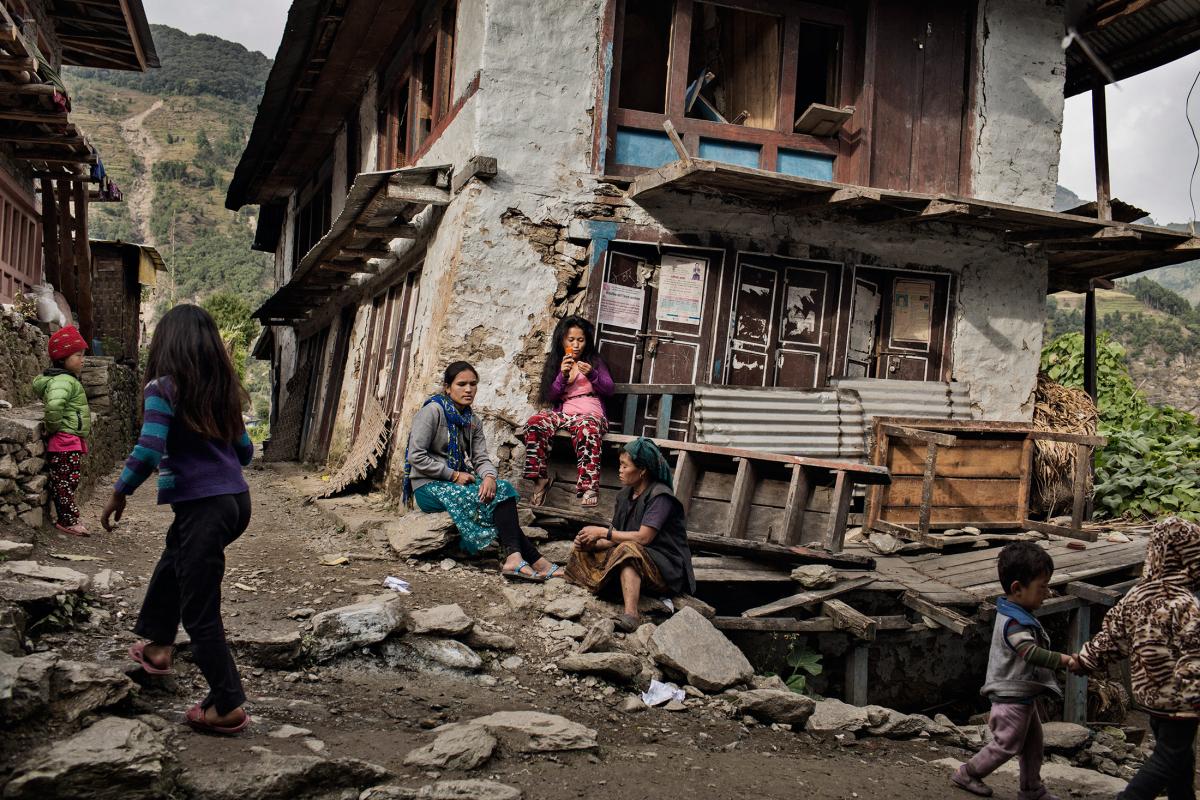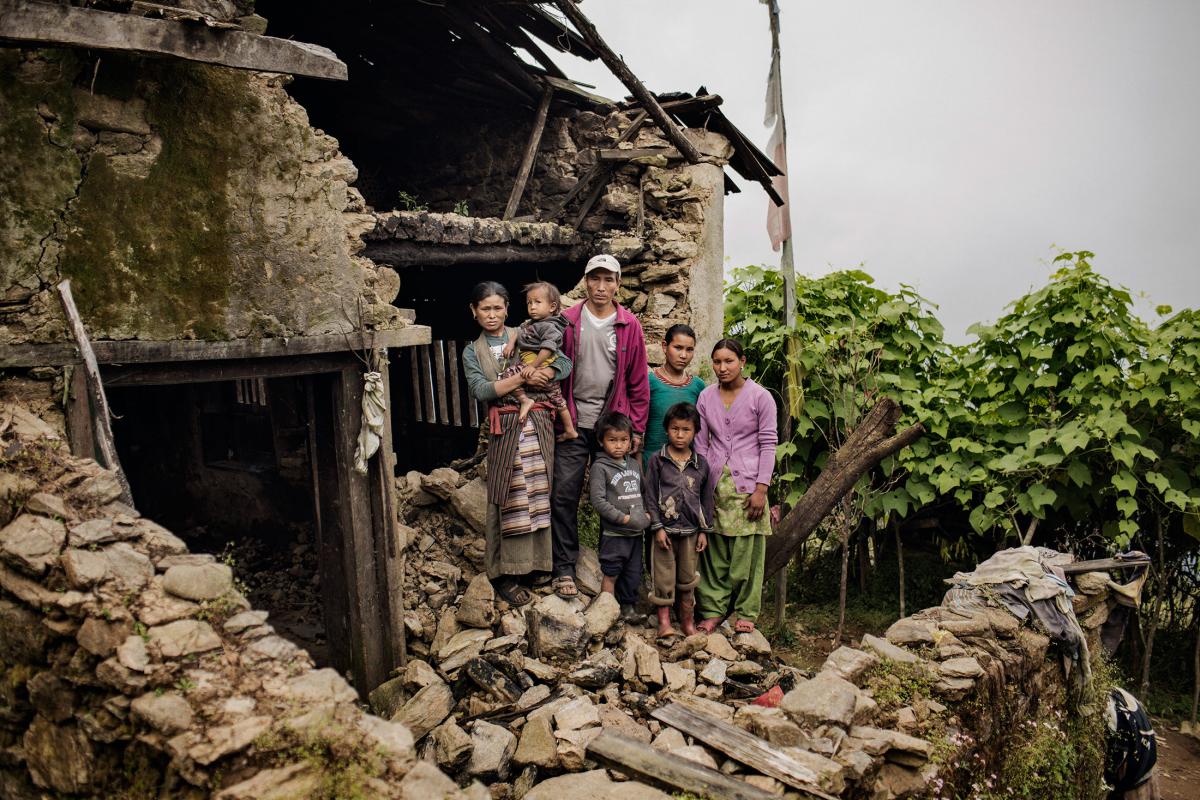Re-Design Phase and Starting Construction
December has been an busy month for our team in terms of redesigning our project with further research of the circumstances and needs of refugees. Janurary marks the start of construction and re-designing our project.
An article by Bloomberg Businessweek ("Toilets, Not Tarps: What People Really Need After a Natural Disaster": December 3rd, Adam Ferguson) discussed how Nepal refugees did not recieve any support funds for shelters until the Fall, when the diaster occured in April. Ferguson states:
It’s Oct. 23, six months after a magnitude 7.8 earthquake and a 7.3 aftershock killed almost 9,000 Nepalis and left hundreds of thousands homeless. Relief arrived in a surge, with international aid organizations delivering bags of rice, pallets of bottled water, and emergency tarps. Now comes the harder, longer work of reconstruction in the rugged Himalayan foothills.

Figure 1: Villagers sit outside an earthquake-damaged shop in Bung village. Photo Credit: Bloomberg Businessweek.
The refugees then spent all of the $150 funds, on food. Nepal faces concerns of lack of gasoline, which affects transportation access. Ferguson notes:
The UN and the U.S. Agency for International Development (USAID) are still delivering supplies, but their efforts have slowed as the government has rationed fuel. In a couple of weeks, at about the same time the government starts selling firewood to desperate citizens, the UN World Food Program will be forced to ground its two supply helicopters.
We were aware of this problem earlier as it was heavily stressed by American Redcross mentors. Our intentions to build a very light-weight design are confirmed. We need to build a shelter that can be easily carried over long distances or consider alternative methods of shipping.

Figure 2: A Sherpa family at their home in Bohane, [Nepal], which was damaged by aftershocks in May. Photo Credit: Bloomberg Businessweek.
They then combined broken houses and metal sheets to provide minimal shelter which is now their current living status. Additionally, Nepal faces political and systematic concerns as country, which prevent help and funds for refugees and communities. Nepal's Government may cause a lot of problems for our project:
Most nonprofits have struggled to build schools, because the government has yet to approve an earthquake-proof design (Ferguson).
We plan to work really hard to create a shelter that is not of unique design, but can actually impact refugees.
After an enlightening skype meeting with Redcross mentor Django Mazars, who is currently volunteering in Haiti, we were informed of the fact that refugees weren't really given tents, but given large pieces of fabric to use as a tarps for covering. We found this method is very common. Mazars was a fan of our idea to use bamboo in construction and also confirmed that any usage of foam should be forbidden because of its environmental impact. He suggestions contacting UNHCR, as we previously had done, and also SPHERE Standards, and UN Habitat, which we then proceeded to contact afterwards. He also mentioned the importance of toliets, as mentioned in the article, and we will start brainstorming more ideas for this after the Mid-Grant Technical Review. Mazars noted that although foundation is most important, rain water harvest is also an important factor to consider:
[Skype message from Djano Mazars 12/14/2015 5:02:29 PM] Rain water harvest is very important also. Forget collecting water that has touched the ground-too risky with epidemics. Roof, yes, into plastic drums. Drainage, yes, but just trenched and soak away to remove stagnant water from underneath... [When asked: "does rain water need any filtering?"] There are little device to let the first rain be evacuated then, no, its okay.
We decided to modify our design to adjust for any type of shelter that would rest on top. We hope to make advantage of existing shelter supplies and materials for the most efficient shelter.
Figure 3: Mac Whitaker (Sustainability Lead) leading decision matrix discussion. Also note some of our rough sketches on the whiteboard for our re-design phase. Photo credit: Pedro Gomez (Admin Lead).
After analzing the problems of our December design, we decided to reinvent our design with intent of better stability. We are now looking at two current interior designs with the new exterior.
The exterior represents bamboo lattice as there are more poles to support the platform upward. This new design is more supportive. We discussed how bamboo wasn't really designed to bend at an angle by itself and needed more support. Our first interior design includes a stretched tarp like material supported by poles. We currently have trampoline-like cloth material which we wish to test and analyze as a possible tarp to hold people. Our other interior design consists of a harder material, either bamboo or wood. We found that metals are too heavy, expensive, and hard to fix during time of diaster.
We are prototyping our ideas currently and plan to have our first final prototype completed by the end of Janurary. We hope to test a working model in Mexio in March. More details on this to come. Also, we are not only contacting orgnatizations who help others with diaster relief and shelters, but also local businesses in engineering and emergency prepartion.
Figure 4: All of our team members brainstorming new ideas during a long meeting. Photo credit: Pedro Gomez (Admin Lead).
Like us on Facebook and follow us on Instagram for more updates!

